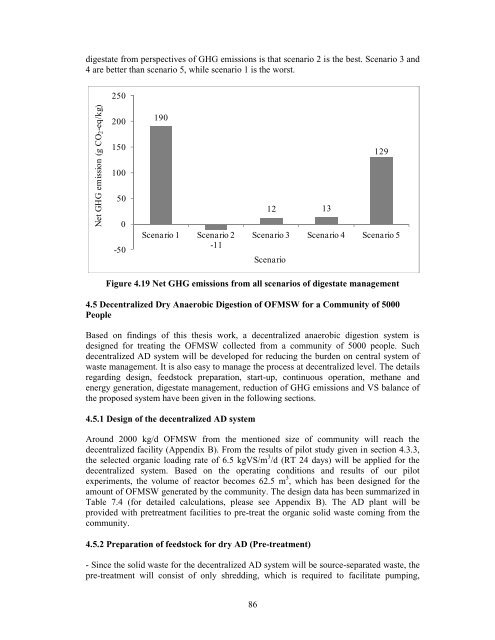dry anaerobic digestion of municipal solid waste and digestate ...
dry anaerobic digestion of municipal solid waste and digestate ...
dry anaerobic digestion of municipal solid waste and digestate ...
Create successful ePaper yourself
Turn your PDF publications into a flip-book with our unique Google optimized e-Paper software.
<strong>digestate</strong> from perspectives <strong>of</strong> GHG emissions is that scenario 2 is the best. Scenario 3 <strong>and</strong><br />
4 are better than scenario 5, while scenario 1 is the worst.<br />
Net GHG emission (g CO2-eq/kg)<br />
250<br />
200<br />
150<br />
100<br />
50<br />
0<br />
-50<br />
190<br />
Scenario 1 Scenario 2<br />
-11<br />
Scenario 3 Scenario 4 Scenario 5<br />
Figure 4.19 Net GHG emissions from all scenarios <strong>of</strong> <strong>digestate</strong> management<br />
4.5 Decentralized Dry Anaerobic Digestion <strong>of</strong> OFMSW for a Community <strong>of</strong> 5000<br />
People<br />
Based on findings <strong>of</strong> this thesis work, a decentralized <strong>anaerobic</strong> <strong>digestion</strong> system is<br />
designed for treating the OFMSW collected from a community <strong>of</strong> 5000 people. Such<br />
decentralized AD system will be developed for reducing the burden on central system <strong>of</strong><br />
<strong>waste</strong> management. It is also easy to manage the process at decentralized level. The details<br />
regarding design, feedstock preparation, start-up, continuous operation, methane <strong>and</strong><br />
energy generation, <strong>digestate</strong> management, reduction <strong>of</strong> GHG emissions <strong>and</strong> VS balance <strong>of</strong><br />
the proposed system have been given in the following sections.<br />
4.5.1 Design <strong>of</strong> the decentralized AD system<br />
Around 2000 kg/d OFMSW from the mentioned size <strong>of</strong> community will reach the<br />
decentralized facility (Appendix B). From the results <strong>of</strong> pilot study given in section 4.3.3,<br />
the selected organic loading rate <strong>of</strong> 6.5 kgVS/m 3 /d (RT 24 days) will be applied for the<br />
decentralized system. Based on the operating conditions <strong>and</strong> results <strong>of</strong> our pilot<br />
experiments, the volume <strong>of</strong> reactor becomes 62.5 m 3 , which has been designed for the<br />
amount <strong>of</strong> OFMSW generated by the community. The design data has been summarized in<br />
Table 7.4 (for detailed calculations, please see Appendix B). The AD plant will be<br />
provided with pretreatment facilities to pre-treat the organic <strong>solid</strong> <strong>waste</strong> coming from the<br />
community.<br />
4.5.2 Preparation <strong>of</strong> feedstock for <strong>dry</strong> AD (Pre-treatment)<br />
- Since the <strong>solid</strong> <strong>waste</strong> for the decentralized AD system will be source-separated <strong>waste</strong>, the<br />
pre-treatment will consist <strong>of</strong> only shredding, which is required to facilitate pumping,<br />
86<br />
12 13<br />
Scenario<br />
129

















